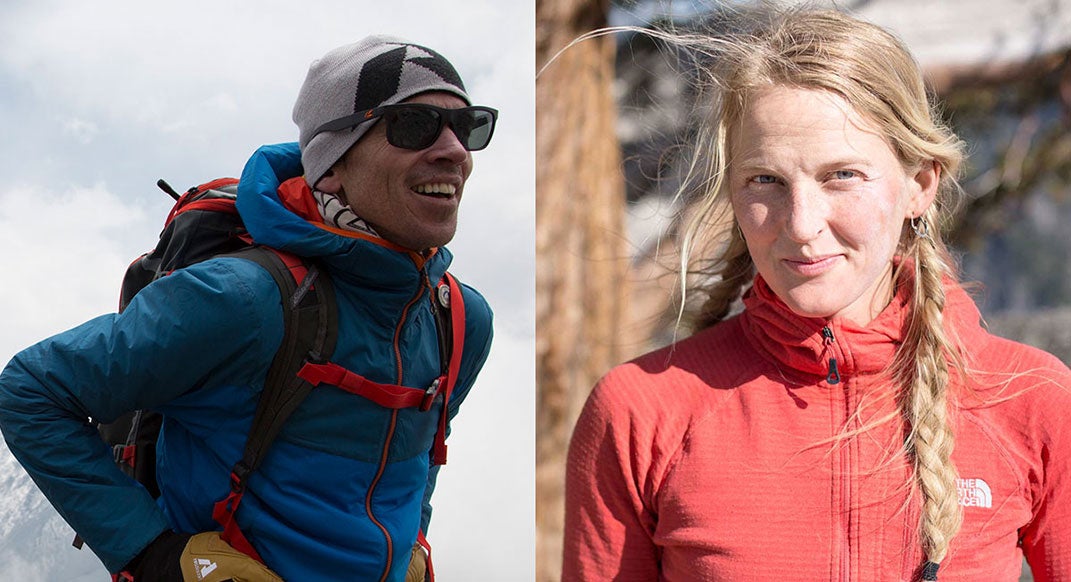Using Trail Running to Train for the World's Sixth-Highest Peak

When Adrian Ballinger and Emily Harrington were training to climb the 26,864-foot summit of Cho Oyu in the Himalayas, they had a consistent training tool.
“We trail run a lot,” says Ballinger, 40, a professional mountain guide and founder of California-based Alpenglow Expeditions. “It’s the single best way we can train cardiovascularly for these mountain expeditions, for uphill travel and for big endurance days,” as well as preparing “the brain and mental side for big days in the mountains.”
Ballinger and Harrington, 30, a top rock climber who has transitioned into mountaineering, met at camp 2 on Everest in 2012, and have been dating since. Ballinger made waves outside the climbing community earlier this year when he, along with Boulder-based climber Cory Richards, attempted to summit Everest via its less-popular northern (Tibetan) route without oxygen, and documented almost the entire climb on Snapchat. Richards successfully summited Everest; Ballinger turned around just shy of the summit with hypothermia.
This week, Ballinger and Harrington are attempting to climb Cho Oyu, on the border of Nepal and China, in a single push, without making the customary series of trips partway up the mountain to acclimate to the altitude. Of course, they are documenting the climb on Snapchat (EverestNoFilter).
We caught up with Ballinger the day before he and Harrington departed for Tibet to ask about the couple’s trail-running regimen and what he thinks of Kilian Jornet, who was planning an attempt on the Mount Everest speed record earlier this month before abandoning it due to weather.
Our training is partially a product of our environment. We live in Squaw Valley [where the Western States 100 starts], and we literally walk out of our house and have two choices: either a two-mile bike path or everything else, which all goes up, fast.
My dad did a lot of marathon running. He’s built like me – I’m six-foot-two, 140 pounds, and he’s six-four, 145 or 150 – and distance running was his main thing. Even though we had a close relationship, I completely shied away from running growing up. I was climbing at 12, and did my first big international peak when I was 17.
I moved to Colorado in my early 20s. I tasted trail running instead of road running and immediately fell in love with it. It’s my main sanity and fitness sport at home.
We never really race, even though we regularly go over the marathon distance. We’re good friends with Scott and Jenny Jurek, and we talk about ultras with them a lot. As I get closer to retiring from 8,000-meter peaks, I’m interested to see if ultras would give similar structure to my training.
I don’t have weekly mileage goals or anything like that. I’m more focused on elevation gain than distance. We usually run four to five times a week, with one or two of them being longer runs with 6,000 to 8,000 feet of gain. The rest are shorter evening runs mixed with some climbing. We will often do one or two laps around a local ski hill. One lap is about 2,000 feet of gain and four-and-a-half miles.
Our longer efforts will combine running and climbing and be really long days. Every week this summer we would do a High Sierra peak, like a 12,000-foot summit; we would run a good distance up to it, do some climbing, come back down and run back. Those days can be 15 to 25 miles, but it’s more about covering the ground and getting a good combination of running and climbing. Those days really prepare us for long days in the mountains. Last week we got caught in a storm and had to get down quickly. A lightweight shell is always essential for a big day like that.
I like to run with music. I’ve always used it for long runs. Wireless headphones make a big difference. I know some people don’t like to run with music. Rory Bosio [winner of the 2013 and 2014 Ultra-Trail du Mont-Blanc] lives and trains here, and she’s very anti-music.
Marmots are probably our biggest wildlife issue. We like to stash packs and marmots like to find the food and carry it away. We’ve run into a few bears around Tahoe, which can be intimidating, but it’s clear they are just as scared of us.
We want to do Cho in a single push. We will use oxygen if we feel it’s necessary, though it would be cool to do it without. Our goal is to do the entire trip, U.S.A. to U.S.A., in two weeks. To our knowledge, that’s never been done with an 8,000-meter peak in less than a month.
The stuff Kilian is doing in terms of breaking fastest known times [FKTs] is incredible. He’s not only a super-talented aerobic athlete, but my understanding is he comes from a deep climbing background and grew up in the mountains. Everest being his first 8,000-meter peak, I was a little surprised at the season and timeline he chose, and I didn’t think they’d get a weather window. I wasn’t surprised when they abandoned it for this year.
But if anyone’s capable of going base-to-summit in a really fast time on Everest, it’s Kilian. He sets FKTs so fast it’s changing people’s perspectives. As soon as those theoretical boundaries are broken, people come back and can better it. I think there’s so much that can be done in our sport as true cutting-edge alpinism evolves and moves forward.